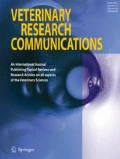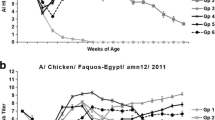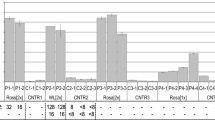Abstract
Avian Influenza (AI) vaccines are widely used for mammals and birds in a trial to eliminate the Avian Influenza virus (AIV) infection from the world. However and up till now the virus is still existed via modulation of its antigenic structure to evade the pressure of host immune responses. For a complete understanding of the immune responses following AI vaccination in chickens, the modulations of the chickens humoral immune responses and interferon-alpha signaling pathway, as a fundamental part of the innate immune responses, were investigated. In our study, we measured the humoral immune response using hemagglutination-inhibition (HI) and enzyme-linked immunosorbent assay (ELISA) tests. In addition, chicken interferon-alpha pathway components was measured at RNA levels using Quantitative Real-time PCR (qRT-PCR) following one dose of inactivated H5N1 influenza vaccine at 14 days of age. In this study, the protective levels of humoral antibody responses were observed at 14, 21 and 28 days following immunization with inactivated (Re-1/H5N1) AI vaccine. In the chicken spleen cells, up regulation in the chicken interferon-alpha pathway components (MX1 & IRF7) was existed as early as 48 h post vaccination and remained until 28 days post vaccination at the endogenous state. However, after the recall with ex-vivo stimulation, the up regulation was more pronounced in the transcriptional factor (IRF7) compared to the antiviral gene (MX1) at 28 days post vaccination. So far, from our results it appears that the inactivated H5N1 vaccine can trigger the chicken interferon-alpha signaling pathway as well as it can elicit protective humoral antibody responses.




Similar content being viewed by others
References
Abdelwhab EM, Grund C, Aly MM (2012) Influence of maternal immunity on vaccine efficacy and susceptibility of one day old chicks against Egyptian highly pathogenic avian influenza H5N1. Vet Microbiol 155:13–20
Aly MM, Arafa A, Hassan MK (2008) Epidemiological findings of outbreaks of disease caused by highly pathogenic H5N1 avian influenza virus in poultry in Egypt during 2006. Avian Dis 52:269–277
Beck JR, Swayne DE, Davison S (2003) Validation of egg yolk antibody testing as a method to determine influenza status in white leghorn hens. Avian Dis 47:1196–1199
De Veer MJ, Holko M, Frevel M, et al (2001) Functional classification of interferon-stimulated genes identified using microarrays. J Leukoc Biol 69:912–920
Geeraedts F, Goutagny N, Hornung V, et al. (2008) Superior immunogenicity of inactivated whole virus H5N1 influenza vaccine is primarily controlled by toll-like receptor signalling. PLoS Pathog 4(8):e1000138. doi:10.1371/journal.ppat.1000138
Grant CE, May DL, Deeley RG (2000) DNA binding and transcription activation by chicken interferon regulatory factor-3 (chIRF-3). Nucleic Acids Res 28:4790–4799
Haller O, Staeheli P, Kochs G (2009) Protective role of interferon-induced Mx GTPases against influenza viruses. Rev Sci Tech 28:219–231
Hwang SD, Kim HS, Cho SW, et al (2011) Single dose of oil-adjuvanted inactivated vaccine protects chickens from lethal infections of highly pathogenic H5N1 influenza virus. Vaccine 29:2178–2186
Jiang H, Yu K, Kapczynski DR (2013) Transcription factor regulation and cytokine expression following in vitro infection of primary chicken cell culture with low pathogenic avian influenza virus. Virol J 10:342–349
Kuribayashi S, Sakoda Y, Kawasaki T, et al (2013) Excessive cytokine response to rapid proliferation of highly pathogenic avian influenza viruses leads to fatal systemic capillary leakage in chickens. PLoS One 8:e68375
Lambrecht B, Gonze M, Morales D, et al (1999) Comparison of biological activities of natural and recombinant chicken interferon-gamma. Vet Immunol Iimmunopathol 70:257–267
Li XY, Qu LJ, Yao JF, et al (2006) Skewed allele frequencies of an Mx gene mutation with potential resistance to avian influenza virus in different chicken populations. Poult Sci 85:1327–1329
Maas R, Rosema S, Van zoelen D (2011) Maternal immunity against avian influenza H5N1 in chickens: limited protection and interference with vaccine efficacy. Avian Pathol 40:87–92
Pena L, Sutton T, Chockalingam A, et al (2013) Influenza viruses with rearranged genomes as live-attenuated vaccines. J Virol 87:5118–5127
Rauw F, Anbari S, Van Den Berg T, et al (2001) Measurement of systemic and local respiratory cell-mediated immunity after influenza infection in chickens. Vet Immunol Immunopathol 143:27–37
Richter MF, Schwemmle M, Herrmann C (1995) Interferon-induced MxA protein. GTP Binding and GTP Hydrolysis Properties. J Biol Chem 270:13512–13517
Shichinohe S, Okamatsu M, Yamamoto N, et al (2013) Potency of an inactivated influenza vaccine prepared from a non-pathogenic H5N1 virus against a challenge with antigenically drifted highly pathogenic avian influenza viruses in chickens. Vet Microbiol 164:39–45
Soejoedono RD, Murtini S, Palya V (2012) Efficacy of a recombinant HVT-H5 vaccine against challenge with two genetically divergent Indonesian HPAI H5N1 strains. Avian Dis 56:923–927
Tian G, Zhang S, Li Y, et al (2005) Protective efficacy in chickens, geese and ducks of an H5N1-inactivated vaccine developed by reverse genetics. Virology 341:153–162
Unitt J, Hornigold D (2011) Plant lectins are novel toll-like receptor agonists. Biochem Pharmacol 81:1324–1328
WHO (2011) Manual for the laboratory diagnosis and virological surveillance of influenza. Identification of the Haemagglutinin subtype of Viral Isolates by Haemagglutination Inhibition Testing Memorandum from a WHO Meeting Bulletin of the World Health Organization 40-127
Wright PF and Webster RG (2001) Orthomyxoviruses. In: Fields BN, Howley PM, Griffin DE, Lamb RA, Martin MA, Roizman B, Straus SE, Knipe DM, editors. Fields virology. 4th ed. By Lippincott Williams & Wilkins Publishers; p. 1254–1292
Author information
Authors and Affiliations
Corresponding author
Rights and permissions
About this article
Cite this article
Abdallah, F., Hassanin, O. Positive regulation of humoral and innate immune responses induced by inactivated Avian Influenza Virus vaccine in broiler chickens. Vet Res Commun 39, 211–216 (2015). https://doi.org/10.1007/s11259-015-9644-3
Received:
Accepted:
Published:
Issue Date:
DOI: https://doi.org/10.1007/s11259-015-9644-3




